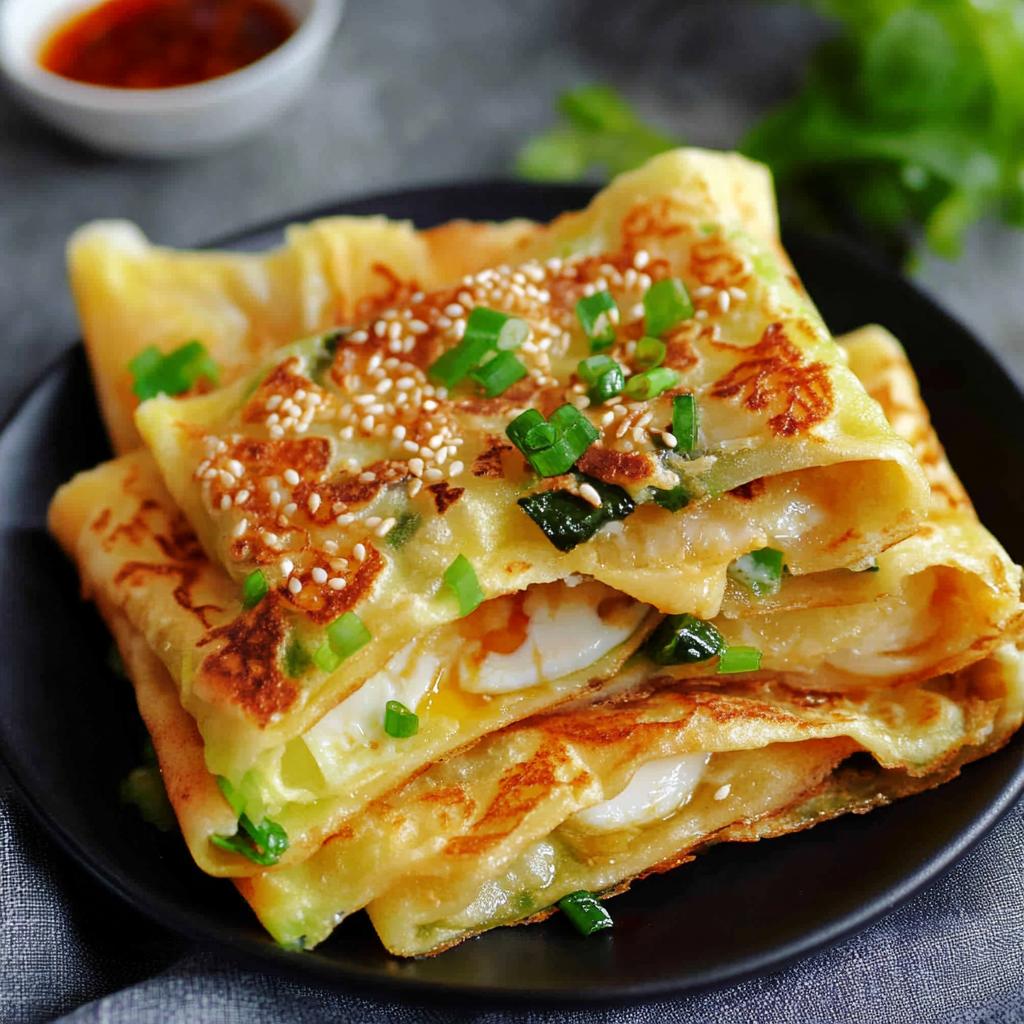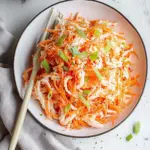Jian Bing, a beloved Chinese street food, is a savory crepe that combines the richness of egg, the crunch of fried wonton wrappers, and the bold flavors of soybean paste and chili garlic sauce. It’s a popular breakfast choice in China, offering a satisfying start to the day. With this recipe, you can recreate the authentic taste of Jian Bing in your own kitchen, bringing a touch of Chinese culinary tradition to your table.
To serve, fold the crepe around the crispy wonton crackers, creating a handheld delight that’s perfect for on-the-go breakfasts or leisurely brunches. The combination of textures and flavors makes Jian Bing a unique and enjoyable dish for any meal.
Full Recipe
Ingredients:
For the crackers:
-
16 ready-made wonton wrappers
-
Cooking oil, for deep-frying
For the batter:
-
70 g all-purpose flour
-
40 g wholemeal flour
-
300 ml water
For the crepes:
-
4 eggs
-
4 teaspoons toasted sesame seeds
-
4 teaspoons finely chopped scallions
For the sauce:
-
4 teaspoons soybean paste
-
4 teaspoons chili garlic sauce
Optional:
-
Fresh coriander
-
Lettuce leaves
Directions:
-
Prepare the crackers: Brush a thin layer of water on a wonton wrapper. Stick another one on top, pressing them together. Cut two lines in the middle. Repeat to make another 7 pairs.
-
Fry the crackers: Heat oil in a wok or pot to 180°C (360°F). Gently slide in the wonton wrappers and flip to fry both sides until lightly golden. Transfer to a plate lined with kitchen paper to absorb excess oil.
-
Make the batter: In a mixing bowl, combine all-purpose flour, wholemeal flour, and water. Stir until smooth.
-
Cook the crepes: Heat a non-stick frying pan over medium-low heat. Pour ¼ of the batter into the pan, swirling to cover the surface evenly. Once the batter firms up, crack an egg on top, spreading it with the back of a spoon. Sprinkle with sesame seeds and chopped scallions.
-
Flip and assemble: When the crepe becomes firm and slides easily, flip it over using a large lid to avoid tearing. Brush with soybean paste and chili garlic sauce. Add fresh coriander and lettuce leaves if desired. Place two fried crackers in the center.
-
Fold and serve: Fold the crepe around the crackers to enclose the fillings. Serve immediately.
Prep Time: 15 minutes
Cooking Time: 25 minutes
Total Time: 40 minutes
Kcal: Approximately 250 kcal per serving
Servings: 4 servings
The Cultural Origins of Jian Bing
Jian Bing (煎饼), often described as the “Chinese breakfast crêpe,” is one of China’s most iconic street foods. Its origins can be traced back over 2,000 years to Shandong province, although variations exist across many northern and central regions of the country. Traditionally sold from roadside carts in the early morning hours, Jian Bing is as much a cultural ritual as it is a beloved dish. It brings together the bustle of morning markets, the smell of sizzling batter, and the rhythmic flipping of crepes that mark the start of the day for millions in China.
This crepe isn’t just a grab-and-go meal—it’s a symbol of local heritage, regional creativity, and communal flavor memories. From students rushing to class to office workers hurrying to beat traffic, Jian Bing is a daily staple that resonates with nostalgia and comfort.
The Unique Structure of Jian Bing
Unlike French crepes or American pancakes, Jian Bing is an engineering marvel of textures. It begins with a thin, soft crepe cooked on a hot griddle. A fresh egg is cracked directly onto the surface and spread thinly, becoming almost fused to the crepe. The egg cooks gently and is topped with toasted sesame seeds and scallions for aroma and bite.
But what truly sets Jian Bing apart is the baocui—the crispy, fried cracker placed inside the folded crepe. Often made from youtiao (Chinese cruller), fried wonton skins, or custom dough, the crunch factor adds contrast and depth to every bite. This texture layering is at the heart of what makes Jian Bing irresistibly addictive.
Flavor Components and Customization
Jian Bing thrives on balance: crispy and soft, savory and spicy, rich and fresh. The flavor base typically comes from soybean paste (doubanjiang or tianmianjiang) and a smear of chili sauce. These are spread on the inside after the egg is cooked, lending umami, salt, and heat. The sauces can be easily adjusted to cater to personal tastes, from extra spicy to slightly sweet.
Fresh herbs like cilantro, shredded lettuce, and even pickled vegetables can be added for brightness and texture. In recent years, some vendors and home cooks have also introduced meats (like sliced sausage or roast duck), cheese, or tofu to modernize and adapt the dish to wider palates, especially outside of China.
Regional Variations of Jian Bing
While the classic northern Chinese Jian Bing uses a batter made from wheat and mung bean flour, other regions employ different flours and fillings. In Tianjin, the crepe may be slightly thicker and chewier. In Shaanxi, it may incorporate a fermented bean paste for a tangy punch. In Taiwan and overseas Chinese communities, you’ll often find egg crepes inspired by Jian Bing, albeit localized with ingredients like Thai chili, teriyaki sauce, or kimchi.
This regional diversity has helped Jian Bing evolve from a street breakfast into an internationally recognized fusion food. It’s not uncommon now to see Jian Bing on menus in cosmopolitan cities like New York, London, or Melbourne.
Why Jian Bing Is Gaining Global Popularity
Jian Bing is riding the wave of global interest in street food culture. It appeals to food lovers who appreciate authenticity, hands-on cooking, and unique combinations of flavor and texture. The DIY nature of Jian Bing also makes it perfect for customization, attracting the same health-conscious and experimental eaters who flock to burrito bars and salad bowls.
Social media has further catapulted Jian Bing into the limelight. Its preparation is highly photogenic—watching the batter spread, eggs sizzle, and fillings fold is mesmerizing. Plus, the end product—golden, folded, crispy, and saucy—is a show-stopper on Instagram and TikTok.
Home cooks are also discovering that Jian Bing is relatively easy to make, especially with common ingredients like eggs, scallions, flour, and chili sauce. This accessibility makes it a rewarding weekend breakfast or a fun, interactive brunch idea.
Nutrition and Dietary Flexibility
Although Jian Bing is indulgent, it’s also nutritionally balanced when prepared mindfully. The base offers carbohydrates and fiber from the flour mix. Eggs add protein and essential fats. Scallions, sesame seeds, and herbs provide vitamins and antioxidants. If you’re frying your own crackers, you can choose high-quality oils or even air-fry alternatives.
Vegetarians will find it easy to adapt. Removing the fried cracker or replacing it with a baked version lowers the fat content. Swapping in plant-based protein like tofu or tempeh can add a nutritional boost. Jian Bing is also naturally nut-free, and gluten-free variations are possible using rice or chickpea flour for the batter.
Jian Bing as a Culinary Experience
Part of Jian Bing’s charm lies in its interactive preparation. It’s not just food—it’s a performance. Whether it’s the swirling of batter across a sizzling plate or the swift folding of the crepe into a tidy, handheld package, making Jian Bing is a rewarding ritual.
Hosting a “Jian Bing brunch bar” is a unique way to entertain friends or family. Lay out toppings and sauces, let each guest assemble their own, and enjoy fresh-off-the-pan crepes that are personalized to perfection. This not only allows for dietary preferences but also turns a simple breakfast into a shared experience.
Cooking Tips and Tricks
The key to perfect Jian Bing lies in timing and texture. Always use a non-stick pan or a large griddle surface that heats evenly. Don’t rush the crepe cooking—wait until the egg layer is just set before flipping. And ensure your fried crackers are thoroughly crispy; any sogginess will affect the structural integrity of the final fold.
If you’re a beginner, start by keeping the fillings minimal. Once you’re comfortable flipping and folding the crepe, experiment with new ingredients and sauces. Keeping extra batter and wrappers on hand ensures that even if your first attempt is imperfect, you’ll have another chance to nail the technique.
The Role of Jian Bing in Chinese Food Culture
Much like the taco in Mexico or the dosa in India, Jian Bing is more than a dish—it’s a cultural anchor. It reflects Chinese ingenuity, regional pride, and the evolution of cuisine in response to lifestyle. It bridges generations and cities, rural towns and global metropolises. It’s food that connects people—simple yet profound, ordinary yet extraordinary.
In Chinese urban centers, Jian Bing is part of a daily rhythm. The vendors who make them often form loyal followings, remembered for their specific sauce blends or folding technique. And now, with recipes available to recreate it at home, Jian Bing becomes not just a meal, but a memory-in-the-making.
Conclusion
Jian Bing stands as a testament to the brilliance of street food—affordable, customizable, full of flavor, and deeply rooted in tradition. Its growing popularity across the world is a reflection of our collective desire for real food with real stories. When you bite into a freshly made Jian Bing, you’re tasting more than eggs, batter, and sauce—you’re experiencing the rhythm of Chinese mornings, the craftsmanship of local cooks, and the magic of culinary fusion.
Whether you’re discovering it for the first time or rekindling an old favorite, Jian Bing offers something truly special: a celebration of culture, taste, and comfort, all wrapped up in one crispy, savory bite.






